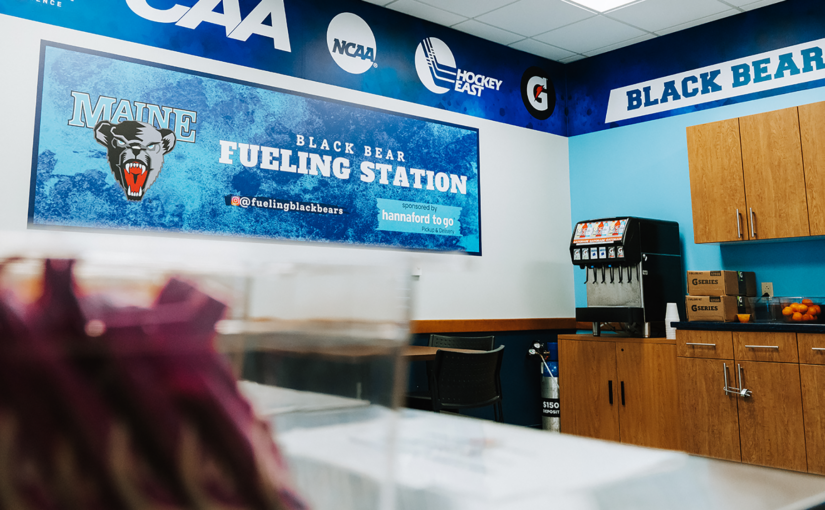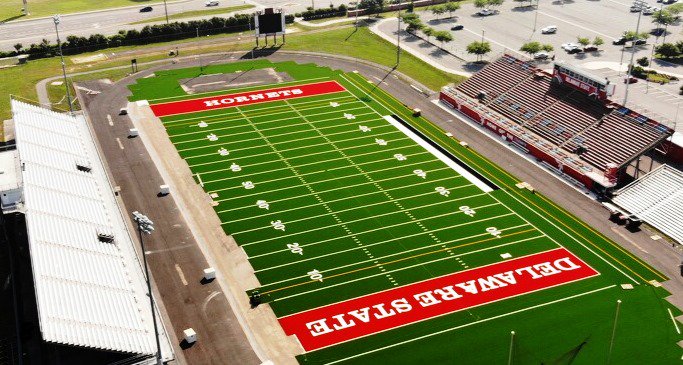Facility Snapshots: Lessons learned from athletic projects around the country
A roundup of 6 athletic projects around the country, and the lessons learned by those in charge.
Kutztown Area High School (Pennsylvania)
In small communities like Kutztown, Pennsylvania, the high school stadium is the epicenter of social gatherings. So, when it came to spending money on major upgrades, it was an easy decision.
“Where the high school goes, the district goes,” said Principal Barry Flicker. “We went through a big renovation and updated our science labs, math wing and mechanics for the entire building. At the conclusion of that we asked, ‘What’s next?”What followed was a $3.4 million investment in the high school athletic facilities. That included a new grass field, an eight-lane track and bleachers to accommodate 1,500 fans. Flicker said nearly 20 percent of Kutztown students participate in track and field, so the district felt it was appropriate to target the outdated track. Expanding to eight lanes also would allow the school to host meets.
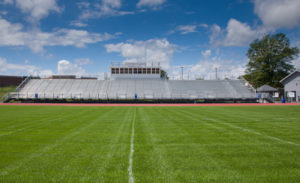
When it came to the field, the school favored natural grass over turf.
“We did that for multiple reasons, and cost is always one,” Flicker said. “(Another is) wear and tear on the body — joints, knees. Things are meant to give, but when you’re on turf, it doesn’t for some reason. It’s better to pull a hamstring or groin than you are to have an ACL injury.”
Project suppliers included Hummer Turfgrass for the field and American Athletic Track and Turf for the track.
Project takeaway: “Continue to overcommunicate,” Flicker said. “Try to consider every stakeholder group under the sun, and when you think you have them all, mark your calendar for another month to find more people. Because you’ll never get everybody.
“Think 10 years into the future. At the same time, remember what’s valued most is the community being together on a Friday night. It’s the little things that bring a community together and make it special.”
Pine Crest School (Florida)
Strength programs have become a critical asset to high school athletic departments nationwide. And having a quality strength program means having the right facilities to run it.
Pine Crest School Athletic Director Jeff Johnson said strength room upgrades had been on his radar for some time. The school was committed to training with two fulltime strength coaches, but the equipment was outdated and the space itself was in need of touching up.
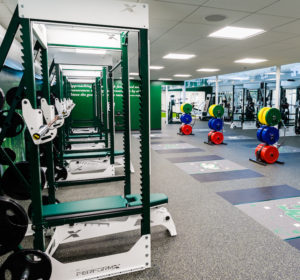
Opportunity presented itself in 2018, when former student and NBA player Brandon Knight told Johnson he wanted to give something back to Pine Crest. Johnson knew exactly what to do.
“Once we got the commitment from Brandon, I knew we needed to upgrade the weight room,” Johnson said. “This had been on my list for some time, because I know every student goes into the weight room. It would give us some momentum with all of our sports programs.”
In late 2018, Pine Crest completed what’s now known as the Brandon Knight Sports Performance Center. The training center was furnished with new racks, cardio equipment, weights and flooring from Perform-X. It also has an indoor turf area. The improvements were undoubtedly a boon to the athletic program, but Johnson said they also provided greater opportunities for physical education classes.
“The old expression is athletic participation increases academic performance,” he said. “So we try to get every students in there to get a break from classes.”
Project takeaway: “Start with the end in mind,” Johnson said. “And know that there’s always going to be some ancillary items that come up that you’re not prepared for. You just have to know that the general project is the most important piece of the puzzle.
“One of the big things I did on this project is defer to the experts. You can’t administrate from behind a desk. Let the people who are working there every day make the decisions.”
Pelham City Schools (Alabama)
Several teams at Pelham High School never had space to call their own, but that’s all changing with the district’s latest facilities projects.
Last fall, the school unveiled its new 16,000-square-foot field house, complete with new locker rooms, coaches’ offices, meeting rooms, and a multipurpose room for strength and conditioning. The facility was two years in the making, and it’s just one phase of a larger initiative to improve athletics throughout the district.
“Nobody in football, soccer or track had their own home, and the (old field house) wasn’t anything that people were taking pride in,” said Kimberly Kiel, director of athletics. “We had a very small weight room that all sports were using. Kids were coming in at 6 a.m. until 7 at night just so all athletes had the opportunity to be trained.”
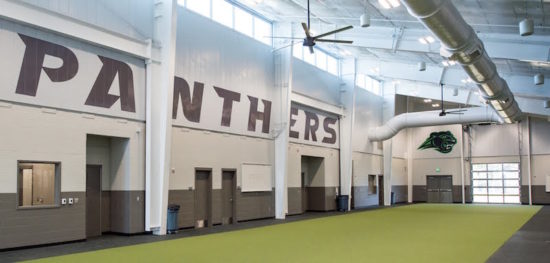
Kiel said the old field house was built in the 1980’s, and it lacked sufficient space for the football team and girls’ programs. It was the school’s mission to build something the athletes could call “home,” and the new field house is a step forward. The new weight room, outfitted by Wright Equipment in Alabama, provides enough space to accommodate up to five teams at once. The old field house will be renovated, providing space for the track and soccer teams.
Kiel said the project involved a lot of collaboration, including the superintendent, board president, director of operations and the football coaches. Construction delays caused by weather forced the school to open the field house three months later than expected, but football players were able to use the facility with two weeks left in their season.
The field house is part of a five-year plan that has already renovated two gymnasiums and built an indoor hitting facility for softball players. The district also built an observation deck at the baseball field.
Project takeaway: “I would go into any project knowing no matter how well you plan, it won’t matter because not everything will go according to plan,” Kiel said. “The thing I learned is patience and flexibility. I also found it helpful to develop a relationship with the construction company, being visible, and speaking with them to be on top of any issues that might be coming.
“Develop a relationship with those people, stay in communication and be flexible.”
Christ School (North Carolina)
Christ School’s new $6 million indoor practice facility will take its athletic program into the future, but not without a nod to its past.
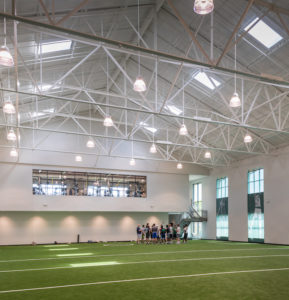
Last spring, the all-boys school located just outside Asheville unveiled its 23,000-square-foot athletic facility, featuring practice space, a new weight room, a 40-yard turf field, and a timeline of its athletic program. Christ School was founded in 1900, and Athletic Director Eric Thorp said the school wanted to make student-athletes cognizant of its rich sports tradition.
“Before, we just had a hall of fame area, and this was more information and a history of athletics, not just athletes individually,” Thorp said. “It’s something we talk about: The long green line of students at Christ School, and being able to show current students what came before them.”
Aside from celebrating its history, Christ School’s indoor practice facility also includes an expanded weight room. Thorp said prior to the project, the program used 800 square feet of old racquetball courts and housed just three squat racks. The new space offers a dozen racks and has the capacity to house multiple teams, making it easier on strength coaches to efficiently train all of the school’s athletes.
In all, the project took nearly 18 months and, because it was a new build, it didn’t displace students or create interruptions in any team schedules. Thorp said it was the school’s first indoor athletic facilities project since 1989.
Project takeaway: “There wasn’t just one person doing the decision making,” Thorp said. “I think that it’s important that the folks who are going to be utilizing the facility, they have a say. The strength coach was involved in discussions about the weight room, and the athletic trainers, and coaches of a specific sport. Maybe not have the ability to make decisions, but get feedback.”
Elyria City Schools (Ohio)
Calvin Coolidge was president when Elyria High School’s stadium was constructed, so it stood to reason that the time had come for serious upgrades.
The school district is in the midst of a $14 million athletic facilities project, which has already seen the construction of a stadium and field house, complete with new locker rooms and a weight room. This year, the district hopes to complete eight tennis courts and eventually begin work on the baseball field.
Athletic Director Heather Beck said the project brings much needed change. The old stadium, built in 1927, featured cramped locker rooms and restrooms. There was little ventilation and no air conditioning in the locker rooms, so football players found little relief during
summer workouts.
“It was long overdue,” Beck said. “Our community has been trying to do something like this since I started in the district 20 years ago.”
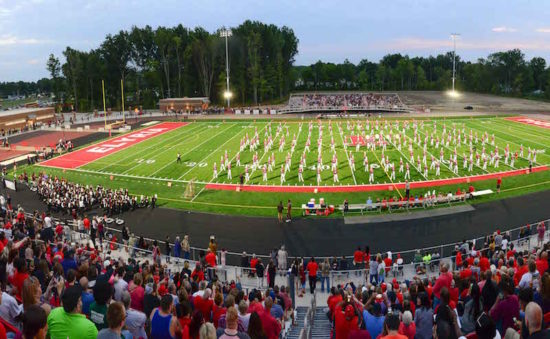
Community support can be a challenge when it comes to costly facility projects, but that wasn’t a problem in Elyria. The former superintendent hosted town halls to describe the project and why it was necessary. An added bonus was that the new stadium would feature artificial turf instead of natural grass, allowing more youth teams throughout the community to use it.
“The community helped pay for it, so we want them to get to use it as well,” Beck said.
Coach feedback was critical to planning, but Beck said the first group she approached was the athletic trainers. Because of the volume of athletes who could be at the facilities in any given time, she wanted to make sure athletic trainers could efficiently and effectively provide oversight.
Project takeaway: “Seek input from your coaches,” Beck said. “While you’re not going to make everyone happy, it’s important that you listen to them, hear their needs, and do your best to accommodate them.
“Patience is a virtue when it comes to this. We had a timeline and, with the weather, you have to be understanding that things are going to change. Believe in the process and the people that you work with.”
Barrington High School (Illinois)
Athletic facility improvements go much smoother when
they come at no cost to the taxpayers, and that’s exactly
what took place at Barrington High School.
Athletic Director Mike Obsuszt said the school installed its new Daktronics videoboard last fall, much to the delight of students and fans in the community. Barrington purchased a new scoreboard when its stadium was built nearly 12 years ago, but the company that installed it went bankrupt, making it difficult for the district to find replacements parts. Luckily, Obsuszt had options.
In conjunction with the district’s stadium project, the school board expanded the program’s ability to sell sponsorships and naming rights. Static signs were attached to the scoreboard and on the press box, and the revenue generated over the last 10 years more than paid for Barrington’s new videoboard.
“(The sponsorships) are all done in a classy way too,” Obsuszt said. “We have only four sponsorship panels adjacent to our scoreboard, so our stadium doesn’t look like a NASCAR facility. We have limited advertising at this point, but it enabled us to have an awesome looking scoreboard and videoboard.”

The video screen on Barrington’s scoreboard measures 25 feet wide and 14 feet high, and the school purchased a second smaller scoreboard installed at the opposite end of the field. Obsuszt said the school doesn’t use it to show replays, but students in the TV production program create highlight videos for the crowds.
“There’s a connection to the curriculum, and I think that’s a big deal,” Obsuszt said.
The sponsorship opportunities created by state-of-theart videoboards have generated a lot of attention in athletic program’s nationwide, and Obsuszt said he’ll soon look into running video ads on the scoreboard. In the end, all the revenue goes back to building a better program for student-athletes.
Project takeaway: Athletic directors might not have time to sell sponsorships or advertisements, but they may not need it. Obsuszt said he was able to rely on a parent group called “Friends of the Stadium” to solicit businesses and community members, taking pressure off of his program.
“They were unbelievable,” he said. “The additional income we got from our original sponsorships helped offset costs of the new synthetic turf field, scoreboard, videoboard and indoor washrooms at the stadium.”

